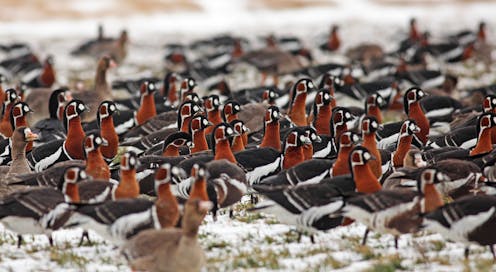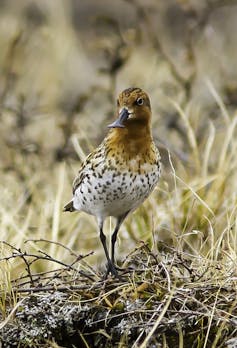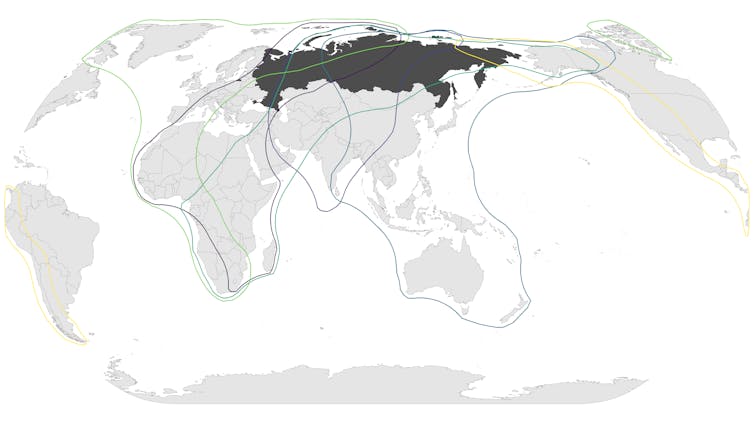
The Russian invasion of Ukraine launched in February 2022 has sent economic, social and political shock waves around the world. In a newly published policy brief, we and other researchers and conservation scientists describe how these effects extend to biodiversity conservation efforts far beyond Ukraine.
Animals, plants and ecosystems don’t recognize political boundaries, so protecting them often requires international cooperation. Over many decades, countries have developed a network of international agreements and arrangements for protecting biodiversity. Now, however, the war at Russia’s hands is delaying a number of those efforts, stopping others, and even sending some into reverse.
War and the spoon-billed sandpiper
As one example, efforts to save the critically endangered spoon-billed sandpiper (Calidris pygmaea) from extinction are now at risk as a result of the war in Ukraine.
Russia’s treeless tundra, in the high Arctic, is the summer home of countless birds that arrive from as far as Africa, southern Asia, Australasia and even South America. Among them is the tiny spoon-billed sandpiper, which weighs in at about 1 ounce (28 grams).

These petite birds nest in the Russian Far East and migrate during the Northern Hemisphere winter to Southeast Asia. Owing to hunting and habitat loss, fewer than 600 of the birds remain.
Since 2012, a multinational team of researchers and conservationists has been conducting a “headstart” breeding program that collects spoon-billed sandpiper eggs from the wild, incubates them and raises chicks in a custom-built aviary on the Russian tundra. This strategy protects chicks from predators, giving them a better chance to reach maturity and reproduce.
Restrictions on international travel to and from Russia have halted this program, which is vital to the sandpiper’s survival, by preventing collaborators from traveling to the site from abroad. Russia has also been suspended from the SWIFT interbank system – the main system that powers secure international fund transfers between financial institutions around the world. This has blocked transfers of much-needed international funds for on-the-ground conservation work.

The Russian invasion is also delaying the potential for conserving critical habitats. For example, important wetlands along China’s coastline that are part of the spoon-billed sandpiper’s migration route have been designated as World Heritage Sites. There is a proposal to expand habitat protection under the World Heritage Convention to other areas along the migratory route, which is also vital for other bird species.
At the time of Russia’s invasion of Ukraine, Russia chaired the United Nations committee that oversees the designation of new sites. Other countries that are signatories to the World Heritage Convention boycotted the process, refusing to operate either in Russia or under Russia’s leadership. Russia has since resigned as the committee chair, but the site designation process has been delayed for over a year.
Russia’s vast lands and waters
Russia has the largest surface area of any country in the world, covering more than 6.6 million square miles (17 million square kilometers). This sheer expanse makes Russia a vital place for biodiversity.
Beyond the spoon-billed sandpiper, birds that visit Russia from other countries include the red-breasted goose (Branta ruficollis), which migrates to areas near the Black Sea, and the gray-cheeked thrush (Catharus minimus), which migrates to South America. In total, Russia is the breeding stronghold for over 500 migratory bird species, of which 52 are threatened with extinction.

Other species also move through Russian territory as they migrate. They include hoofed mammals, such as the wild forest caribou (Rangifer tarandus fennicus), and the critically endangered saiga antelope (Saiga tatarica). Russia’s waters are home to numerous fish species, including commercially valuable ones like salmon and sturgeon.
In terms of ecosystems, Russia has the world’s largest and most well-preserved forests. They provide vital habitats for many species and contain enormous stores of carbon, so protecting them has global implications for addressing climate change. Farther north, about half of the Arctic Ocean’s coastline, including locations that have experienced relatively little human impact, lies within Russia.
A link in global conservation networks
Russia has been involved in international efforts to manage and conserve species for over a century, starting in 1911 when it signed the North Pacific Fur Seal Convention. Since then, Russia has joined more than 50 international agreements for biodiversity conservation, including the Convention on Biological Diversity, the East Asian-Australasian Flyway Partnership and the China-Russia Bilateral Migratory Bird Agreement.
Now Russia’s diplomatic isolation is hampering work under multilateral arrangements like the Arctic Council, which includes the eight countries with Arctic territory and a half-dozen regional Indigenous organizations. Since Russia invaded Ukraine, the council has halted its operations, although it aims to resume some on a limited scale that excludes Russia. The Arctic Council has a working group on biodiversity conservation, including specific initiatives to conserve migratory birds.
Russia also has been an important participant in transnational collaborative research on wildlife and biodiversity issues. For example, to conserve migratory animals, researchers need to understand their movements. This makes it possible to identify and protect the animals’ key habitats.
Icarus, a collaborative research initiative for understanding animal migration, has relied on data sharing by Roscosmos, the Russian space agency. This partnership has now been suspended, leaving Icarus in search of an alternative solution.
The war in Ukraine has also created an imperative for countries to prioritize some issues over biodiversity conservation. For example, Russian attacks on Ukrainian farms and related infrastructure, and Russian naval blockades of grain exports, have contributed to global food shortages. In response, the European Union has sought to increase agricultural output by rolling back some of its biodiversity-friendly farming policies.
For as long as the war in Ukraine lasts, we believe it is imperative for other countries to increase their efforts to strengthen and expand the international system for biodiversity conservation in the rest of the world. In our view, this should happen even as governments rightly assist Ukraine’s valiant efforts to regain full control over all of its territory, including its wetlands, forests and other important habitats currently occupied by Russian forces.
Eduardo Gallo-Cajiao receives funding from the David H. Smith Conservation Research Fellowship Program.
Duan Biggs is the Olajos Goslow Chair at Northern Arizona University and receives funding from the United Nations, and the IUCN, and previously WWF the Luc Hoffmann Insitute, and the Australian Research Council.
Nives Dolsak and Paul G. Harris do not work for, consult, own shares in or receive funding from any company or organization that would benefit from this article, and have disclosed no relevant affiliations beyond their academic appointment.
This article was originally published on The Conversation. Read the original article.







